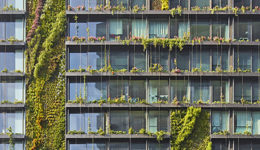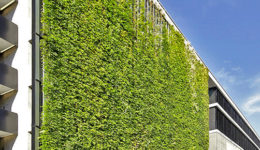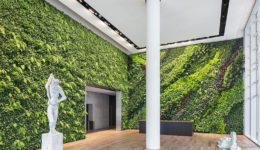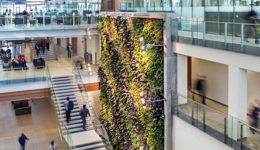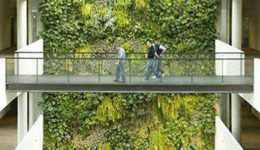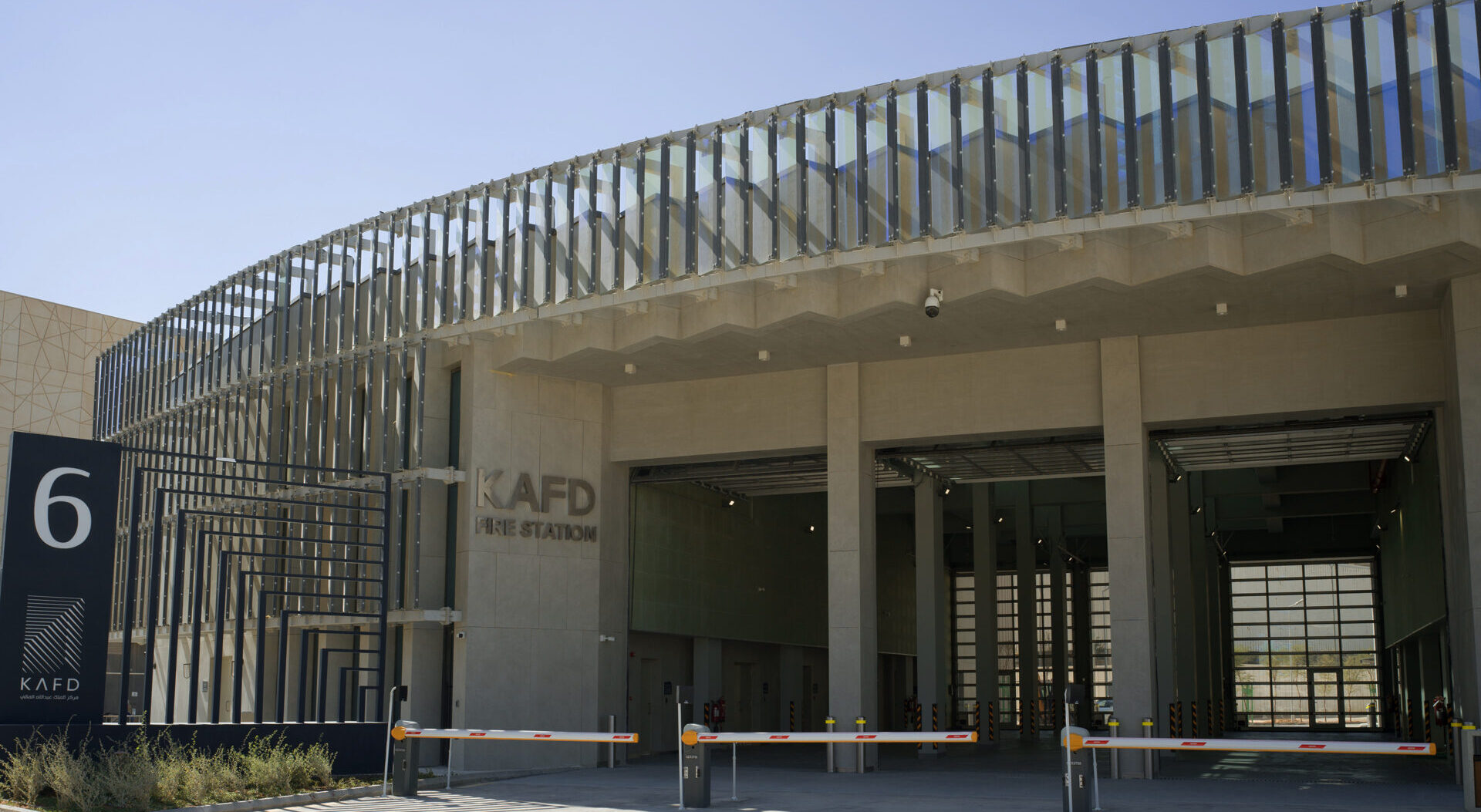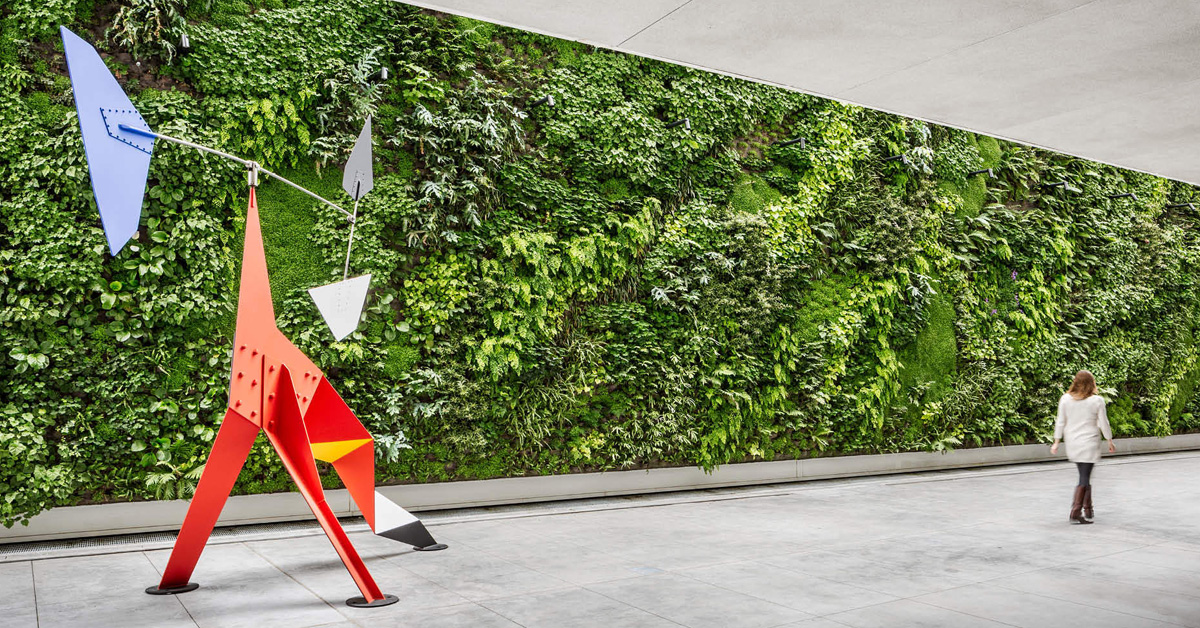 San Francisco Museum of Modern Art Living Wall, by Habitat Horticulture. Photo © Habitat Horticulture
San Francisco Museum of Modern Art Living Wall, by Habitat Horticulture. Photo © Habitat Horticulture .
Architects are collaborating more and more creatively with botanists to create vertical gardens and true living walls in which plants can thrive without soil—enhancing the architecture and the environment.
By Peter Bogaczewicz, Senior Architect
There was a time, not too long ago, when the sight of plants climbing up walls or emerging from building facades would be taken as a sign of a building’s age, neglect, or status as an architectural ruin. But today, such an occurrence is often the result of conscious architectural decision-making. The relationship between the natural and the man-made environment is becoming more carefully calibrated along with the rise of sustainability and environmental design thinking. Increasingly, architects embrace the advantages of introducing living systems into their designs. One concept stands out as perhaps the clearest and most literal representation of a sensitive architectural response to living harmoniously with nature: the “green wall.”
A green wall, as the name implies, is quite simply a building wall that is partially or completely covered with vegetation growing either from the ground or in vertically supported soil or inorganic growing medium. The concept of the architectural green wall dates back at least to the 1930s, when an American professor of landscape architecture named Stanley Hart White developed what he called “botanical bricks,” which he later expanded into a patented “vegetation-bearing architectonic structure.” However, White’s particular invention was somewhat impractical and wasn’t implemented on any significant scale.
The idea of a “living wall” was fully realized in 1986, when botanist Patrick Blanc, working alongside architect Adrien Fainsilber and engineer Peter Rice, completed the first large-scale indoor living wall at the Cité des Sciences et de l’Industrie science museum in Paris. Blanc’s interpretation of the green wall concept arrived at an elegantly simplified, easily adaptable system that required no soil, and which could be applied to walls of varying sizes to stunning effect. As Blanc said:
“Plants don’t need soil because it is merely the mechanical support. Only water and the minerals dissolved in it are essential to plants, together with light and carbon dioxide to conduct photosynthesis. Wherever water is available all year long, as in tropical forests or in temperate mountain forests, plants can grow on rocks, tree trunks, and slopes free of the ground. For instance in Malaysia 2,500 species grow without any soil.”
It was Blanc’s reimagining and re-engineering of the living wall that paved the way for further innovations in this area and a surge in the number of architects incorporating green walls into their buildings.
Contemporary green walls fall into two main categories: traditional walls adorned with climbing plants that are rooted in the ground, referred to as “green facades,” and true “living walls,” which are specially constructed to provide a vertical growing surface for plants using various growing mediums, supports and integrated irrigation systems. The latter can have sophisticated assemblies and controls capable of regulating peak performance with a measurable effect on such things as indoor air quality, giving them the further descriptor of “active” green walls.
Both of these basic types offer unique benefits. The climbing plant system can only be installed on building exteriors, often incorporating a specifically designed trellis, cable, or other external support to protect the building and prevent structural damage. These external green walls have no bearing on the building walls and can easily be replaced or removed, yet can reduce the amount of energy required to cool a building by lowering the ambient temperature of its exterior surface — essentially shading the building — provide protection from UV radiation, and divert water away from walls during heavy rain. In some cases, they can even serve as acoustical insulation to reduce the transmission of noise.
A living wall system (also referred to as a bio-wall, ecowall or vertical garden) differs from green facade in that it can be installed almost anywhere in or upon a building and may be freestanding or attached to an existing wall. It is typically more permanent and is composed of a structural framework supporting a layered assembly or modular panels that contain a growing medium — such as packed soil, fiber mats, or some other substrate — and an integrated irrigation system that cycles water through the panels as needed. Living walls can be further categorized according to the type of growth medium (loose media, mat media, and structural media)and support system (panel/modular systems, tray systems and freestanding walls) they use.
In addition to more effectively providing many of the same benefits of the climbing plant system, living wall systems provide other benefits that enhance the sustainability of a building and the well-being of its occupants or users. Interior living walls can help create healthier and more relaxing environments not only by releasing oxygen in exchange for carbon dioxide, but also by attracting dust particles, absorbing and processing toxins in the air, and by naturally humidifying dry air.
However, a complex living wall system will always require a certain degree of professional knowledge and maintenance to keep healthy. The use of climate-appropriate flora, highly efficient irrigation systems, and a provision for the right air moisture content should always be considered, and are practical concerns for living walls in our own arid desert climate. Even carefully designed living walls installed within controlled interior environments may require special considerations, such as misting devices to counteract the dryness of conditioned air.
Constructing and successfully maintaining green walls is neither easy nor inexpensive, but an increasing number of building owners are nevertheless starting to see them as a worthwhile investment. Of course, it takes no special technical knowledge to appreciate green walls’ aesthetic appeal. These wonders of horticulture and architecture have the power to transform even a bland, ordinary space into a wonderfully inviting vertical garden, giving new meaning to the word “wallscape.” Architects are beginning to learn to use living walls not just to make a statement, but toenhance livability, occupant quality-of-life, and energy performance— and in some cases, to humanize an otherwise uninviting environment. In our cities that too often seem detached from nature, green walls can play a meaningful, even poetic role in bringing us back into balance.
As an architecture and engineering firm, Omrania stands at the forefront of innovation, making a significant impact among architecture firms in Riyadh, Saudi Arabia, with its sustainable and forward-thinking designs.














